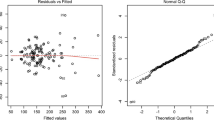Summary
The genetic variance among F2-derived lines of backcrosses (BCgF2-derived lines) depends on the backcross generation (g), the number of F1 plants crossed and selfed in generations 1 through g, and the number of BCgF2-derived lines evaluated. Additive genetic variance decreases linearly with backcrossing when one BCF1 plant per generation is crossed and selfed. The relationship is curvilinear if more than one BCF1 plant is used; as the number of BCF1 plants increases, additive genetic variance among BC1F2-derived lines approaches that among BC0F2-derived lines. The effect of population size on genetic variance is due both to fixation of alleles in previous generations and to sampling of genotypes in the population being evaluated. Dominance and repulsion linkage can cause small increases in genetic variance from BC0 to BC1.
Similar content being viewed by others
References
Bailey TB (1977) Selection limits in self-fertilizing populations following the cross of homozygous lines. In: Pollack E, Kempthorne O, Bailey TB (eds) Proc Int Conf Quant Genet. The Iowa State University Press, Ames, Iowa, pp 399–412
Baker RJ (1976) Some thoughts about backcrossing and quantitative traits. Wheat Newslett 22:43–44
Bulmer MG (1980) The mathematical theory of quantitative genetics. Clarendon Press, Oxford
Cox TS, Frey KJ (1984) Genetic variation for grain yield and related traits in sorghum introgression populations. Theor Appl Genet 68:145–153
Dudley JW (1982) Theory for transfer of alleles. Crop Sci 22:631–637
Hill J (1966) Recurrent backcrossing in the study of quantitative inheritance. Heredity 21:85–120
Lawrence PK, Frey KJ (1975) Backcross variability for grain yield in oat species crosses (Avena satival L. x A. sterilis L.). Euphytica 24:77–85
MacKey J (1963) Autogamous plant breeding based on already high-bred material. In: Akerberg E, Hagberg A (eds) Recent plant breeding research, Svalof 1946–1961. John Wiley, New York, pp 73–88
Reddy BVS, Comstock RE (1976) Simulation of the backcross breeding method. 1. The effect of herilability and gene number on fixation of desired alleles. Crop Sci 16:825–830
Rodgers DM (1982) Improvement of cultivated barley (Hordeum vulgare) with germplasm introgressed from H. spontaneum. PhD dissertation. Iowa State University, Ames, Iowa. University Microfilm No. 82-21223
Wright S (1931) Evolution in Mendelian populations. Genetics 16:97–159
Author information
Authors and Affiliations
Additional information
Communicated by A. L. Kahler
Joint contribution of USDA-ARS and Journal Paper No. J-11095 of the Iowa Agriculture and Home Economics Experiment Station, Ames, Iowa. Project No. 2471
Rights and permissions
About this article
Cite this article
Cox, T.S. Expectations of means and genetic variances in backcross populations. Theoret. Appl. Genetics 68, 35–41 (1984). https://doi.org/10.1007/BF00252308
Received:
Issue Date:
DOI: https://doi.org/10.1007/BF00252308




